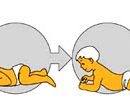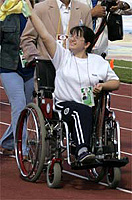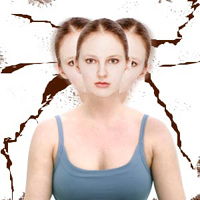Why hydrocephalus develops in children? How to make sure your child has no hydrocephalius? Answers to these questions you will find in this article.
Content
Hydrocephalus in children
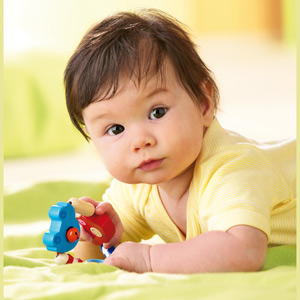 Hydrocephalus — This is an excessive increase in the sizes of the skull in children caused by an increased amount of spinal fluid. Parents more familiar with another name of the disease – “Washer brain”.
Hydrocephalus — This is an excessive increase in the sizes of the skull in children caused by an increased amount of spinal fluid. Parents more familiar with another name of the disease – “Washer brain”.
Recall that the inner medium of the central nervous system is a spinal fluid, which is called cerebrospinal fluid (CSW) or liquid (from Liquores - liquid), that is, inside the brain, the brain is surrounded from all sides with liquid, it seems to float in it, which creates for the brain Additional damage protection. In the brain itself, there are cavities that are called brain ventricles, there are only four of them. They are also filled with spinal fluid. This liquid is ultrafiltrate blood and is produced by special brain structures - vascular plexuses located in ventricles.
A newborn child has a total number of cerebrospinal fluid, 15-20 ml, aged 1 – 30-35 ml, in adults – 120-150 ml. At hydrocephalus, the capacity of the CSC may increase to 1-1.5 liters. The intensity of the formation of the CSZH in children is higher than in adults. During the day in young children, the spinal fluid is completely updated 6-8 times.
Its circulation occurs under the influence of brain ripples, as well as breathing, head movement, production speed and reverse absorption.
Causes of development
Causes of the development of hydrocephalus are diverse: malformations of development, intrauterine infection, pathology about pregnancy or childbirth, tumors, injuries, bleeding and many others. Very often, in cases where the hydrocephalus developed intrauterine, the reason to establish is very difficult.
Hydrocephalus occurs when violating the circulation of liquor. For example, when an obstacle occurs on the current of the current cerebrospinal fluid; Incretion increases or reduces its absorption.
The accumulation of fluid leads to an increase in one or more ventricles of the brain, the thinning of the brain itself, the compassion of the furrow and atrophy of various brain structures.
The following forms of hydrocephalus differ: open (reported) and closed (occlusive), outdoor and internal; For the flow - sharp and chronic, compensated and decompensated. The open form of hydrocephalus is characterized by the expansion of all ventricular brain systems and the absence of an obstacle to cerebrospinal fluid current throughout the liquor system. With the closed form of hydrocephalus, the violation of the shelter inside the ventricular system can be associated with its development anomalies, adhesive processes, neoplasms.
Symptoms of hydrocephaliya
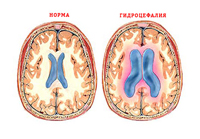 With the extended form of hydrocephalus, dimensions and shape of the skull change — His brain department is significantly dominated by the facial, the frontal part sharply acts forward, in the field of temples and forehead there is a pronounced venous network. Little children have an expansion and blowout of the spring, partial displacement of the eyes under the edge of the lower eyelid – The so-called symptom “The setting sun”. Rodnichok – This is a non-woolen section of a skull of a skull with a layer of connective tissue. Distinguish the rear and front springs. Rear Spring, or Small, located between the occipital and dark bones. This spring closes at the end of the intrauterine period or from the first week after birth by the end of the 3rd month of life. Front spring, or large, is located between frontal and dark bones and has a rhombus shape. It closes to 12-15 months of life. At the hydrocephalius of the spring remains open for a long time.
With the extended form of hydrocephalus, dimensions and shape of the skull change — His brain department is significantly dominated by the facial, the frontal part sharply acts forward, in the field of temples and forehead there is a pronounced venous network. Little children have an expansion and blowout of the spring, partial displacement of the eyes under the edge of the lower eyelid – The so-called symptom “The setting sun”. Rodnichok – This is a non-woolen section of a skull of a skull with a layer of connective tissue. Distinguish the rear and front springs. Rear Spring, or Small, located between the occipital and dark bones. This spring closes at the end of the intrauterine period or from the first week after birth by the end of the 3rd month of life. Front spring, or large, is located between frontal and dark bones and has a rhombus shape. It closes to 12-15 months of life. At the hydrocephalius of the spring remains open for a long time.
Excessive head growth can be observed in the intrauterine period, and this is a factor that impedes the normal flow of labor.
Clinically hydrocephalus is manifested by various symptoms of the impaired function of the nervous system: trembling of hands, chin, feet, convulsive twitching or convulsions, violation of the movement of eyeballs. Various vegetative violations can be joined - the pallor of the skin, heart rate disorders. With a difficulty outflow of a liquor and a pronounced increase in intracranial pressure, crises are developing with a very strong headache, vomiting. Gradually develops a decrease in visual acuity. With progressive hydrocephalus, children can lag in development. They become less mobile because they are hard to hold their heads.
In older children, the skull is strong enough, and the growth of the sizes of the head in the formation of hydrocephalus is impossible. Therefore, excess fluid causes an increase in intracranial pressure, which is manifested by headache, drowsiness, vomiting, trembling of hands and eyeballs, pathological reflexes when examining a neurologist.
Sometimes, along with the general lag in mental development, children with this disease observed an extraordinary mechanical memory, the ability to account, to foreign languages, music. With compensated forms of hydrocephalus, despite the increase in intracranial pressure, clinical symptoms are absent and the nervous psychological development of the child does not suffer. In such cases, the hydrocephalus is sometimes detected as a random find with a radiological examination of the skull over another disease.

